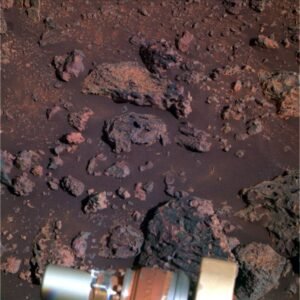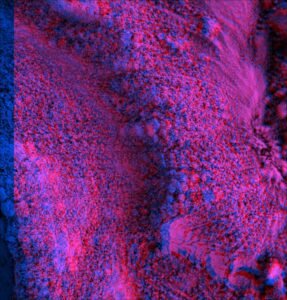Latest Posts
Formations in context (or what?)
Certain details of the Martian surface can look strange, unless you take a look at the context to which they belong.This image, in particular, shows us a detail of a crater located at about 28 ° south latitude in mid-winter.The interior of this crater shows clear signs of glacial flows, very frequent at mid-latitudes of Mars, demonstrating the abundant presence of water just below the surface.Complete HiRISE image: https://www.uahirise.org/ESP_053734_1515 Reference article NASA JPL: https://www.jpl.nasa.gov/spaceimages/details.php?id=PIA22348 This post has been automatically translated. See the original post here.
LPSC 2018:Studying young Mars by analyzing river structures
At the Mars section of the Lunar and Planetary Science Conference (LPSC), held on March 20 of this year, an afternoon was devoted to as many as six speakers who focused their talks on Martian protolagos and all the associated river structures.The surprises are remarkable and numerous and rewrite the hydrogeological history of Mars in a very interesting way.It is really worth to download for free all the six reports listed in this summary PDF: https://www.hou.usra.edu/meetings/lpsc2018/pdf/sess251.pdf Happy reading! 😉 This post has been automatically translated. See the original post here.
Opportunity Sol 5042, March 31, 2018
Between 18:57:49 UTC and 19:01:11 UTC the Pancam of Opportunity takes three images with narrow band filters in the three basic colors, from which it was possible to obtain this extraordinary true color image of the Martian soil.Also in this photo, as in the one of the previous Sol (see https://www.facebook.com/PianetaMarte.MdM/photos/a.1625578140858706.1073741828.1612043482212172/1658008487615671/), you can see very interesting colorations between green and green-blue looking very similar to the lichens on Earth.Obviously the fact that they “look like” lichens does not necessarily mean that they are!However, I find the photo is still of extreme interest, especially for those who like me follow the studies of Dr Gilbert Levin and his staff. RGB HD unprocessed (raw) image: https://image.ibb.co/hwJVqS/Oppy_Sol5042.jpg Original BN images: Red (735nm with 20nm bandwidth)18:57:49 UTC14:38:39 LTST https://mars.nasa.gov/mer/gallery/all/1/p/5042/1P575789669EFFD225P2538L2M1.HTML Green (535nm with 20nm bandwidth)18:59:29 UTC14:40:16 LTST https://mars.nasa.gov/mer/gallery/all/1/p/5042/1P575789769EFFD225P2538L5M1.HTML Blue (432nm with 32nm bandwidth)19:01:11 UTC14:41:56 LTST https://mars.nasa.gov/mer/gallery/all/1/p/5042/1P575789871EFFD225P2538L7M1.HTML This post has been automatically translated. See the original post here.
I share a post of Pianeta Marte.net by Matteo Fagone with great pleasure: “Martian atmosphere rarefied or not?
It is one of the most intriguing question, so much to have become object of bitter diatribes between many people belonging to the conspiracy and anti conspiracy bangs. Every now and then we too are targeted in these ridiculous infighting when we dare to open our mouths on this fascinating topic. Recently, a passing user has brought to our attention the following official NASA document as proof that we are obviously wrong (and therefore we should be ugly conspiracy theorists): https://www.grc.nasa.gov/www/k-12/airplane/atmosmrm.html Let us premise, however, that we were already aware of this work, among other things quite dated. A document that all things considered could have a substantial validity. Who knows, maybe it is even correct….However the vexata questio is very different from what our “hit and run friend” probably imagined. We tend to be more “advanced” than those who make assessments on the basis of a single report, even if it is a NASA report. In fact, we have adopted a more elaborate methodology, based on the Mars Climate Database (NASA and ESA): http://www-mars.lmd.jussieu.fr/mcd_python/ It is useless to make a list of the advantages, but we know well that anyone who has a minimum of familiarity with this valuable tool has no doubt about it. For this reason we have questioned several reports and official NASA communiqués for the simple fact that one fundamental thing is missing. The possibility to falsify their data is missing. There is a lack of official references from other space agencies. Science requires the possibility of verification by others of the results produced by others. We are not interested in the responsibility of anyone if one lies and the other does not. We don’t give a damn! We do not walk by faith towards a body now considered as a god. In the documentary about the unfortunate Schiaparelli accident we have explained why we believe that the Mars atmosphere is denser than we can imagine. In this article we explained why suspended dust is evidence of a dense atmosphere: http://www.pianetamarte.net/marsdust.htm And in this documentary many other things…. https://youtu.be/gtGNIGvkTKo Everything else is beyond our interest….” This post has been automatically translated. See the original post here.
Color and detail changes at Viking lander landing sites
In the post devoted to a recent image taken by Opportunity https://www.facebook.com/PianetaMarte.MdM/photos/a.1625578140858706.1073741828.1612043482212172/1658008487615671/?type=3 ), I mentioned green spots observed during the Viking mission.This is the 1978 article by Dr. Gilbert Levin cited in the post indicated above…. This post has been automatically translated. See the original post here.
Layered alluvial deposits and phyllosilicates on Mars
A most interesting study of the traces left by massive amounts of water that shaped the surface of Mars! This post has been automatically translated. See the original post here.
Opportunity Sol 5041, March 30, 2018
Between 18:01:22 UTC and 18:02:48 the Pancam of Opportunitytakes three images with narrow band filters in the three basic colors, from which it was possible to derive this extraordinary true color image of the Martian soil.Personally, I was extraordinarily impressed by the greenish spots clearly visible on the larger rocks. They remind me very much of a similar phenomenon described by Dr. Gilbert Levin who during the mission of the Viking probes described the formation of greenish spots on the rocks near the two landers during the hottest periods of the Martian year.Obviously from a single photo is not possible to establish anything certain, since it could well be even simple minerals such as serpentine or olivine.However, I find it equally very interesting, who knows if Opportunity will have the opportunity to analyze them revealing their true nature.Biological or mineral origin? Unprocessed RGB HD image (raw): https://image.ibb.co/mfyHKn/Oppy_Sol5041.jpg Original BN images: Red (735nm with 20nm bandwidth)18:01:22 UTC14:22:05 LTST https://mars.nasa.gov/mer/gallery/all/1/p/5041/1P575699888EFFD225P2447L2M1.HTML Green (535nm with 20nm bandwidth)18:01:56 UTC14:22:39 LTST https://mars.nasa.gov/mer/gallery/all/1/p/5041/1P575699922EFFD225P2447L5M1.HTML Blue (432nm with 32nm bandwidth)18:02:48 UTC14:23:29 LTST https://mars.nasa.gov/mer/gallery/all/1/p/5041/1P575699974EFFD225P2447L7M1.HTML This post has been automatically translated. See the original post here.
InSight: Digging Deep into Mars
A great press conference held last night at 11pm, with a beautiful presentation of the capabilities of the InSight probe and much more… Speakers:– Thomas Zurbuchen, associate administrator for NASA’s Science Mission Directorate in Washington, D.C.– Bruce Banerdt, InSight principal investigator at JPL– Tom Hoffman, InSight project manager at JPL– Jaime Singer, InSight instrument deployment lead at JPL This post has been automatically translated. See the original post here.
Successful first test of the largest parachute ever used in a mission to Mars
For the next European mission to Mars in 2020, new techniques will be applied to ensure a good landing.Two parachutes instead of just one, in particular the second will be the largest parachute ever used for a landing on Mars, well 35 meters in diameter.This first test was carried out releasing everything from 1.5 km altitude, but is planning a second test starting from 30 km altitude to simulate more closely the “real” Martian conditions. Let’s hope well…. This post has been automatically translated. See the original post here.
Opportunity Sol 5036, March 25, 2018
Combining two other shots taken by the Microscopic Imager at 14:42:20 UTC (for the left eye) and 14:41:21 UTC (for the right eye) I obtained this fantastic 3D image to observe the special glasses with red and blue lenses.This image takes an area adjacent to the image of the previous post (see: https://www.facebook.com/PianetaMarte.MdM/photos/a.1625578140858706.1073741828.1612043482212172/1654805961269257/). The original images have been rotated 90° clockwise to allow a correct three-dimensional view, without undergoing further processing.Also in this image you can see how the ground has a curious filamentous texture very complex and very interesting! 3D HD image: https://image.ibb.co/io0WqS/Oppy_Sol5036_02.jpg Original images: SX14:42:20 UTC14:20:14 LTST https://mars.nasa.gov/mer/gallery/all/1/m/5036/1M575255973EFFD1BQP2966M2M1.HTML DX14:41:21 UTC14:19:16 LTST https://mars.nasa.gov/mer/gallery/all/1/m/5036/1M575255914EFFD1BQP2935M2M1.HTML This post has been automatically translated. See the original post here.


